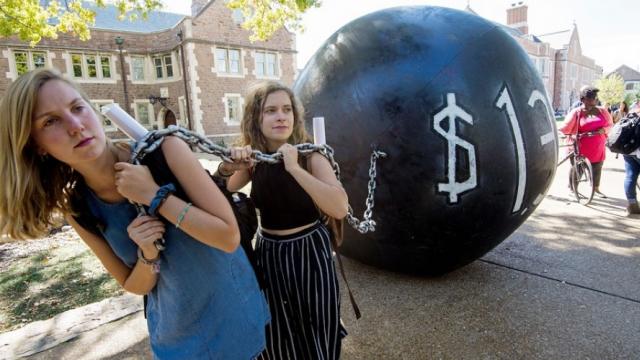
A new study explores the economic benefits of cancelling student debt. (Photo: Getty)
It's been almost a year since the Republican Party and President Donald Trump delivered their behemoth giveaway to the nation's corporations and wealthiest individuals by passing a $1.5 trillion controversial tax bill that will ultimately blow a $5 trillion hole—or larger—in the nation's budget.
On Monday morning, Bloomberg reported that the amount of U.S. student loan debt has more than doubled since 2009 and now sits at a record $1.47 trillion.
That's interesting. Those numbers are very similar in size.
Meanwhile, also on Monday morning, Forbes noted how—due to the fraudulent practices of for-profit colleges and under orders from a federal court—the U.S. Department of Education will cancel $150 million in student loans, proving the federal government does, indeed, have the power to leverage its authority to correct an economic wrong.
As good as it might be for those students who are having their debt cancelled, $150 million is just 0.01 percent of the nearly $1.5 trillion in overall student debt liability.
While a majority loans are held by private institutions, Paul Della Guardia, economist at the Institute of International Finance, explained to Bloomberg that "over 90% of student loans are guaranteed by the U.S. Department of Education." When the next economic downturn hits or if "a recession causes a rise in youth unemployment and triggers mass defaults," warned Della Guardia, "this contingent liability could prove burdensome for the U.S. government budget."
So if it's possible to forgive a small portion of the overall student debt—and if the country can afford to give away $1.5 trillion in tax revenue, mostly to the wealthy and companies that don't need it—why not just forgive all of the outstanding U.S. student debt?
Some economists think it's a brilliant—and practical—idea. Earlier this year, a team economists published a paper detailing the macroeconomics benefits of mass student debt cancellation.
According to the paper, put out through the Levy Economics Institute of Bard College, forgiving the more than $1.4 trillion in outstanding student loan debt held by approximately 44 million Americans would boost the nation's gross national product anywhere from $86 billion to $108 billion annually for the first decade following the debt cancellation.
"Getting rid of the debt," reported MarketWatch at the time of the paper's release, "would also lower the average unemployment rate by 0.22 to 0.36 percentage points over 10 years and could add between 1.2 million and 1.5 million jobs per year."
In February of 2018, economist Stephanie Kelton, a fellow at the Sanders Institute and one of the authors of that study, sat down with Jane Sanders, co-founder of the institute, to discuss why the cancelling all U.S. student debt is not only possible, by a viable and smart financial prescription.
Originally published on Common Dreams











